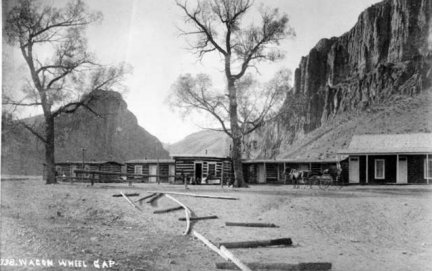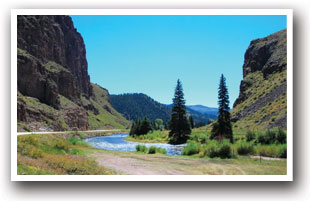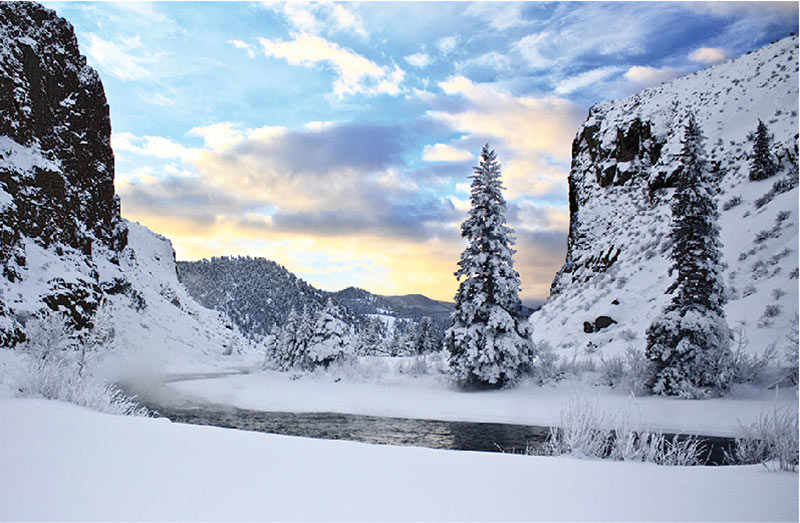Mineral County COGenWeb
COGenWeb a proud partner of USGenWeb
History of Wagon Wheel Gap
 Wagon Wheel Gap, village, Mineral county., SW Colo., on Rio Grande, in San Juan Mts., and 8 mi/12.9 km SE of Creede. Elev. c.8,390 ft/2,557 m.
Wagon Wheel Gap, village, Mineral county., SW Colo., on Rio Grande, in San Juan Mts., and 8 mi/12.9 km SE of Creede. Elev. c.8,390 ft/2,557 m.
Fishing resort with mineral springs; kayaking. Surrounded by Rio Grande National Forest.
 West of Del Norte, at South Fork, the highway branches, with the main thoroughfare continuing west over Wolf Creek Pass to Durango. The other road turns up the North Fork of the Rio Grande and follows the canyon past the rugged cliffs to Wagon Wheel Gap, where the rocks close in and form a gateway through which there is scarcely room for the river, the railroad, and the road to pass. The origin of its name is usually attributed to the finding of a wagon wheel beside the road, discarded by some freighter or prospector as he worked his way through the cut. On the other hand, the Gap is known to have been the scene of a big Indian battle after which, according to one lurid account, the Indians stretched a rope between the cliffs over the river, festooned it with the scalps of the whites they had killed and weighted it with a wagon wheel dangling from the middle.
West of Del Norte, at South Fork, the highway branches, with the main thoroughfare continuing west over Wolf Creek Pass to Durango. The other road turns up the North Fork of the Rio Grande and follows the canyon past the rugged cliffs to Wagon Wheel Gap, where the rocks close in and form a gateway through which there is scarcely room for the river, the railroad, and the road to pass. The origin of its name is usually attributed to the finding of a wagon wheel beside the road, discarded by some freighter or prospector as he worked his way through the cut. On the other hand, the Gap is known to have been the scene of a big Indian battle after which, according to one lurid account, the Indians stretched a rope between the cliffs over the river, festooned it with the scalps of the whites they had killed and weighted it with a wagon wheel dangling from the middle.

Miner Charles Baker wrecked his wagon and lost a wheel here while fleeing the area after a confrontation with the Ute Indian, Colorow, on his way to Baker's Park (now Silverton). Colorow was known to be hostile towards miners because they offended the gods by digging into the earth and removing precious rocks. A wagon wheel was later found stuck in the mud and the  "place where the wagon wheel was found" was later shortened to Wagon Wheel Gap. "Gap" means where the canyon narrows. This location became an important supply town and stage stop in the 1870s, serving as the first tollgate for the stage road between South Fork and Lake City.
The area below Wagon Wheel Gap was spiritually significant to the Utes because of the healing powers of the nearby hot mineral waters. The Utes called themore than thirty bubbling pools "Little Medicine." A worn trail led south and ended at "Big Medicine," or Pagosa Springs, that settlers later developed into privately owned hot spring resorts.
Wagon Wheel Gap colorado historical society WJH 2938
"place where the wagon wheel was found" was later shortened to Wagon Wheel Gap. "Gap" means where the canyon narrows. This location became an important supply town and stage stop in the 1870s, serving as the first tollgate for the stage road between South Fork and Lake City.
The area below Wagon Wheel Gap was spiritually significant to the Utes because of the healing powers of the nearby hot mineral waters. The Utes called themore than thirty bubbling pools "Little Medicine." A worn trail led south and ended at "Big Medicine," or Pagosa Springs, that settlers later developed into privately owned hot spring resorts.
Wagon Wheel Gap colorado historical society WJH 2938
This page was last updated